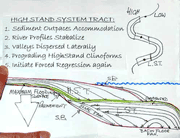The streamed video chalk board lecture below explains the ideal Vail et al 1977 sequence, and considers this in terms of the component systems tracts, and their gross geometries as products of changes in relative sea level (base level) and the evolving accommodation' space. You are introduced to sea level and base level, sequence, concepts of sequence stratigraphy from the perspective of evolving sediment geometry through time, and relative sea level changes. The geological setting described in the lecture is hypothetical, and represents the first of a series of other hypothetical and real geological examples of clastic and carbonate sequences that are described in the pages that follow.


Downloads Formats:
The movie makes the following points:
The lecture seen in the movie involves a geologic model that makes the following assumptions::
- Sea level position varied
- Subsidence was constant
- Sediment supply was constant
The sequence is divided by surfaces systems tracts. Each systems tract is represented by a collection of the sediments of the associated sedimentary depositional systems that were active during the different phases of base level change. Thus systems tract sediments can be considered as sedimentary units that were deposited synchronously and can be mapped as being enclosed by continuous surfaces that extend from sub-aerial and to sub-aqueous settings.
The systems tracts defined in order of deposition to form the ideal sequence are:
Early phase lowstand systems tract is associated with:
Late phase lowstand systems tract is associated with:
Transgressive systems tract is associated with:
Highstand systems tract is associated with:
- Slow rise of relative sea level followed by a slow fall; essentially a still stand of base level when the slower rate eustatic change balances that of tectonic motion
- Sediment outpacing loss of accommodation
- River profiles stabilize
- River valleys are dispersed laterally in a position landward of the shelf margin.
- Prograding highstand clinoforms develop capped by aggrading topsets that become thinner upward.
To view carbonates and clastics with different inputs we refer you to the Quick Time movies on our page.